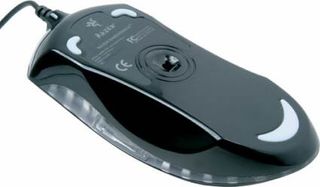Razer's Diamondback: The Mouse that Roars?
The Concept Of Speed

But resolution is where Razer has really gone all out. The Diamondback has an internal resolution of 1600 cpi. That's 1600 reports per inch traversed! It's an awesome figure, but you have to wonder if it's really useful. Here, we'll have to go back over the concept of resolution itself - but read our previous articles if you want a more complete description.
The number of measurements for a given distance covered is what determines the speed of pointer movement. The more measurements taken for a given distance, the smaller the distance to be traversed physically. Speed also depends on the resolution of the screen. The higher it is, the higher the mouse's resolution will have to be for an equivalent speed. An example will make that clearer.
At 400 cpi and a screen resolution of 1024 x 768, the mouse needs to make a physical movement of 5 cm to move the pointer completely across the screen diagonally.
| Header Cell - Column 0 | 1024 x 768 | 1600 x 1 200 |
|---|---|---|
| 400 cpi | 5 cm | 7 cm |
| 800 cpi | 2.5 cm | 3.5 cm |
| Row 2 - Cell 0 | ||
| Row 3 - Cell 0 | 1024 x 768 | 1600 x 1 200 |
| 400 cpi | 5 cm | 7 cm |
| 800 cpi | 2.5 cm | 3.5 cm |
There are some benchmark values you can use to get your bearings in terms of a standard mouse. At 1024, a maximum of 400 cpi can be considered sufficient. At 1600, that figure will be 800. But another factor comes into play in what's already a complex concept: personal perception of speed. Some people do very well with a faster mouse, and others don't. There's a precision / speed ratio. The more you increase the resolution of a given mouse, the harder it will be to reposition it precisely. So it's a question of striking a balance. And, to throw in just a little more complication, the more precise a mouse is the more you'll be able to speed it up without losing accuracy. Finally (just to make sure the issue is almost incomprehensible to you by now), the adjustment of this value in Windows is done by software means. You go into the mouse settings and adjust the pointer speed to change the resolution. And depending on the manufacturer's adjustment of the mouse, the relation between the resolution of the mouse and the adjustment in Windows differs. With the slide positioned in the middle, a Razer mouse will be faster than a Logitech, which in turn will be faster than a Microsoft mouse. If you set the speed to the maximum, you go beyond the physical resolution of many mice and you lose precision. That's the case with the Microsoft mouse, for example.

Stay on the Cutting Edge
Join the experts who read Tom's Hardware for the inside track on enthusiast PC tech news — and have for over 25 years. We'll send breaking news and in-depth reviews of CPUs, GPUs, AI, maker hardware and more straight to your inbox.
Most Popular

